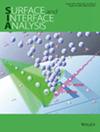脉冲电流对含石墨氧化铝涂层表面性能的影响
IF 1.8
4区 化学
Q4 CHEMISTRY, PHYSICAL
引用次数: 1
摘要
阳极氧化是一种广泛应用于铝合金的表面处理方法,通过增加氧化层的厚度来改善其表面性能。一般来说,传统的直流阳极氧化会产生高孔隙率和微裂纹。利用脉冲电流(PC)作为电源,石墨颗粒作为氧化层的增强剂可以解决这些问题。因此,本工作旨在研究组合方式对涂层生长和氧化涂层表面特性的影响。采用直流和PC硬质阳极氧化工艺,在AA2017‐T4铝合金表面制备了石墨复合氧化物涂层。评估了表面形貌、形貌、化学成分和表面硬度。在PC阳极氧化中,氧化层的生长速度(0.59 μm/min)比DC阳极氧化(1.08 μm/min)慢。与DC相比,表面孔隙在30分钟开始发育,DC是20分钟。60 min时,PC孔尺寸(宽46.74±19.96 μm,深7.11±2.57 μm)、DC孔尺寸(宽81.03±21.60 μm,深17.16±4.31 μm)、厚度为64.80±23.69 μm的多孔复合氧化物涂层形成完成。PC复合氧化物涂层的表面粗糙度和硬度分别为1.90±0.04 μm和379.10±4.37 HV。同时,表面粗糙度显著增加(4.28±0.25 μm),硬度显著降低(302.75±1.09 HV)。石墨颗粒的引入使氧化膜的表面孔隙率和微裂纹减少,表面硬度提高。本文章由计算机程序翻译,如有差异,请以英文原文为准。
Effect of pulse current on surface properties of aluminum oxide coating containing graphite
Anodizing is widely used as a surface treatment for aluminum alloy to improve its surface properties by increasing the thickness of the oxide layer. Generally, conventional anodizing by direct current (DC) produced high porosity and micro‐cracks. Utilizing pulse current (PC) as a power source and graphite particles as reinforcement for the oxide layer may solve these problems. Therefore, the present work aims to study the effect of the combination approaches on coating growth and the surface characteristics of the oxide coating. The graphite‐incorporated composite oxide coating on the AA2017‐T4 Al alloy was developed by DC and PC hard anodizing process. The surface morphology, topography, chemical composition, and surface hardness were evaluated. In PC anodizing, the growth rate of oxide layer was slower (0.59 μm/min) than DC anodizing (1.08 μm/min). The surface pores start to develop at the 30th minute compared to DC, which is the 20th minute. At 60 min, the formation of porous composite oxide coating is complete with pore dimension (width: 46.74 ± 19.96 μm and depth: 7.11 ± 2.57 μm) and thickness of 35.20 ± 8.90 μm for PC, whereas for DC pore dimension (width: 81.03 ± 21.60 μm and depth: 17.16 ± 4.31 μm) and thickness of 64.80 ± 23.69 μm. Surface roughness and hardness of composite oxide coating by PC were measured at about 1.90 ± 0.04 μm and 379.10 ± 4.37 HV, respectively. Meanwhile, the DC reveals a significant increase in roughness (4.28 ± 0.25 μm) and a decrease in hardness (302.75 ± 1.09 HV). The introduction of graphite particles with PC anodizing reduces the surface porosity, microcracks and enhances the surface hardness of oxide coating.
求助全文
通过发布文献求助,成功后即可免费获取论文全文。
去求助
来源期刊

Surface and Interface Analysis
化学-物理化学
CiteScore
3.30
自引率
5.90%
发文量
130
审稿时长
4.4 months
期刊介绍:
Surface and Interface Analysis is devoted to the publication of papers dealing with the development and application of techniques for the characterization of surfaces, interfaces and thin films. Papers dealing with standardization and quantification are particularly welcome, and also those which deal with the application of these techniques to industrial problems. Papers dealing with the purely theoretical aspects of the technique will also be considered. Review articles will be published; prior consultation with one of the Editors is advised in these cases. Papers must clearly be of scientific value in the field and will be submitted to two independent referees. Contributions must be in English and must not have been published elsewhere, and authors must agree not to communicate the same material for publication to any other journal. Authors are invited to submit their papers for publication to John Watts (UK only), Jose Sanz (Rest of Europe), John T. Grant (all non-European countries, except Japan) or R. Shimizu (Japan only).
 求助内容:
求助内容: 应助结果提醒方式:
应助结果提醒方式:


